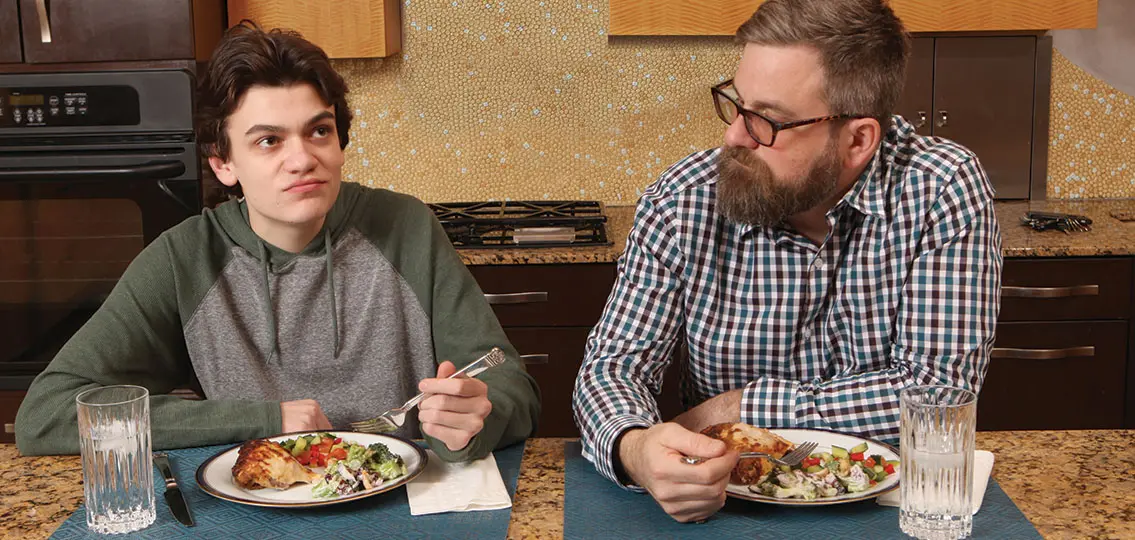As the mom of a 13-year-old son, I’m used to monosyllabic answers (and occasional grunts) to my questions about school, homework, friends, you name it. But I don’t give up that easily—I look for clues about how Ryan’s feeling by checking out his posture and his general physical demeanor.

In fact, paying attention to your teen’s body language—and modifying yours—can help you connect with your kid. It can be a window into how your kid is feeling, even when they don’t want to tell you.
“Over 90 percent of emotions are conveyed through nonverbal communications,” explains David B. Givens, Ph.D., director of the Center for Nonverbal Studies in Seattle. “With teenagers, because their prefrontal cortex of the brain isn’t fully developed yet, you need to include some nonverbal information for your message to get through.”
That connection matters to kids. “Parents should keep in mind that as kids get older, their relationships with their peers increase in importance but their relationships with their parents don’t decrease in importance—especially if they’re having trouble with their peers,” says child psychologist Eileen Kennedy-Moore, Ph.D., author of the forthcoming Kid Confidence. “Parents are a source of comfort and acceptance.”
Body Language Tips to Enhance Communication with Teens
1. Create a level playing field.
There’s a tendency as adults, and especially as parents, to take an authoritative position. (Say your kid is sitting at the kitchen table doing homework—and you stand over him, asking if he’s completed everything.) This isn’t conducive to connecting. Instead, get on the same level as your kid—like sitting next to him on the couch.
“You want your eyes to match up and your heads to be on the same level,” says Givens. “That’s a good thing for rapport.” (I have some of my best conversations with Ryan when I sit on his bed at night.)
2. Ease up on the eye contact.
“Kids can be defensive or nervous when they’re talking to adults, even when that adult happens to be their parent,” says Givens. “Be aware of the eye contact that’s going on—don’t pin the child down with a fixed gaze. This can stimulate the fight-or-flight reaction.”
In other words, some eye contact is good, but it shouldn’t be paramount to the conversation—kids naturally seek less eye contact than adults. This is why you may have some great conversations in the car, where eye contact is naturally limited.
Less eye contact gives “kids room to talk without being judged and room to explore,” says Kennedy-Moore.
3. Monitor your hand gestures.
Adults tend to use authoritative hand gestures, where the hand is pronated and parallel to the floor. Instead, use hand gestures where the palms are up and open toward the ceiling—these are natural rapport builders.
You can also learn a lot from your teen’s hand movement. A sudden cessation of hand gestures can indicate that your kid is being less than honest.
“If your child is gesturing and you get to a sensitive spot and their hands stop, that gives you an opportunity to probe a little more deeply,” says Givens. “They may be hiding something … or not telling the truth.”
4. Use touch wisely.
That toddler who used to smother you with hugs now squirms away from you? That doesn’t mean to give up on physical touch.
“Touch is very important—it’s our most basic way of connecting and comforting,” says Kennedy-Moore. “But follow their lead about what kind of touch works best. Some teens are fine with hugs and some are more self-conscious, especially around friends.” She recommends “sneaky nurturing,” like walking by and giving them a quick shoulder squeeze or hair touch without stopping.
“You keep going and you’re gone before they can object,” she says. Even those small touches can keep a bridge between you and your teen.
By tuning into the messages we send with our bodies, not just our words, we may just find a whole new level of understanding with our teens.

QUICK TIP:
Consider your own mental state when you’re talking with your teen. If you’re distracted or annoyed or exhausted, it may not be the best time for a heart-to-heart. One of the best times to connect is over food. “Eating is a parasympathetic response, which signals ‘digest and relax,’” Givens says. That helps set the stage for a connected conversation.




